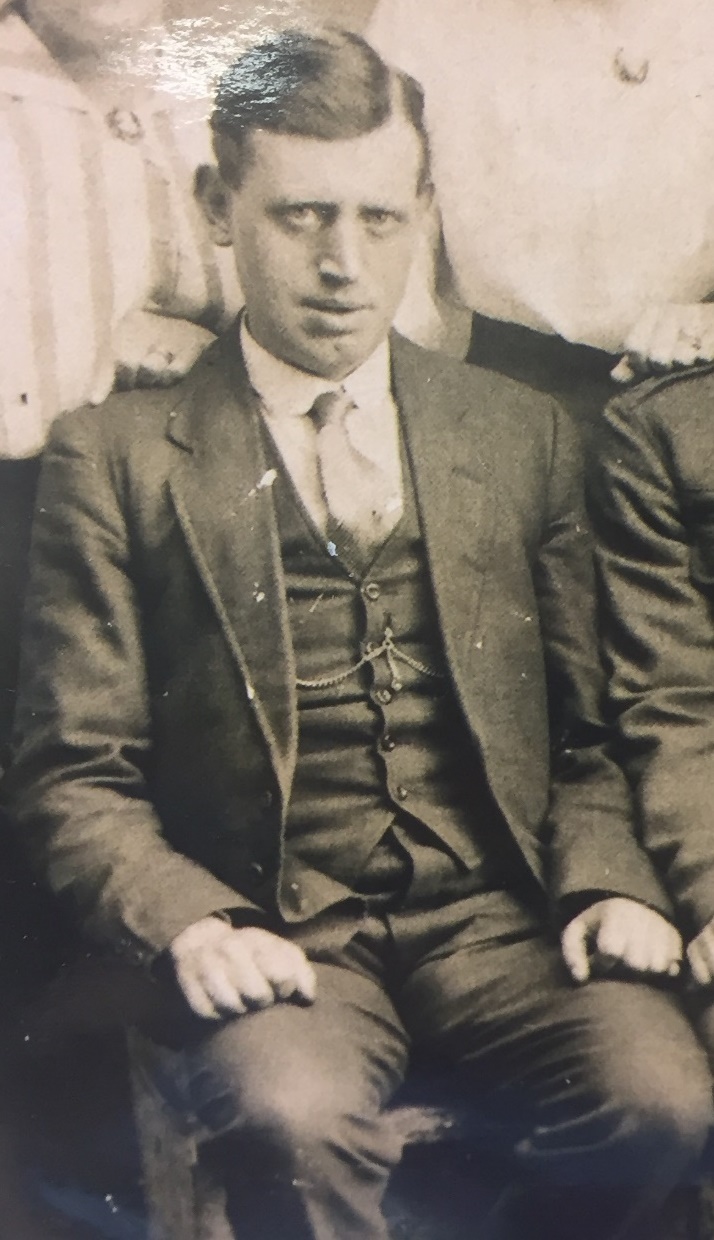Pte
Edward Thomas
Informations sur naissance
|
Année de naissance: 1896 |
|
Lieu de naissance: Welshpool, Montgomeryshire, Pays de Galles, Royaume-Uni |
Informations service militaire
|
Pays: Pays de Galles, Royaume-Uni |
|
Force armée: British Expeditionary Force |
|
Rang: Private |
|
Numéro de service: 292999 |
|
Incorporation nom de lieu: Welshpool, Montgomeryshire, Pays de Galles, Royaume-Uni |
|
Unités: — Cheshire Regiment, 16th Bn. (Dernière unité connue) |
Informations sur décès
|
Date de décès: 22/10/1917 |
|
Lieu de décès: Colombo House, Belgique |
|
Cause du décès: Killed in action (K.I.A.) |
|
Âge: 21 |
Mémorial
|
Tyne Cot Memorial Panneau: 63 |
Distinctions et médailles 3
|
British War Medal Médaille |
|
Territorial War Medal Médaille |
|
Victory Medal Médaille |
Points d'intérêt 2
| #1 | Lieu de naissance | ||
| #2 | Lieu d'enrôlement |
Mon histoire
Private Edward Thomas served in the 16th Battalion Cheshire Regiment, part of the 105th Brigade of the 35th Division. This battalion was founded in Birkenhead as a Bantam Battalion, a battalion in which men smaller than the allowed length could enlist. The 105th Brigade took part in the First Battle of Passchendaele, one of the last phases of the Third Battle of Ypres. Their objective was a road south of Houthulst Forest.
On October 22, the 16th Battalion Cheshire attacked in the early morning in very bad weather conditions. They were on the right flank of the 105th brigade. The 16th Cheshire advanced from positions west of les 5 chemins. Heavy rain and constant shelling had turned the terrain into a swamp. Due to the sorry state of the ground the Battalion had a lot of difficulties following the artillery barrage, which was moving forward at a very slow pace of 100 yards per 8 minutes. Despite of the rain and mud, the right of the 16th reached their objective at Marechal Farm with relative ease. However the center and left were held up near Colombo House by fire from blockhouses in Houthulst Forest. It was decided to consolidate the line.
In the afternoon, however, a German counterattack broke through on the left of the 16th. The Germans broke through and the surviving Cheshires had to fall back to positions near their original line. Eventualy they restored the line with help from other units. After the counterattack, the 16th was relieved by the 15th Battalion.
During the attack on the 22nd of October 1917 the 16th lost more than a third of their soldiers that day. Private Edward Thomas was one of them. He possibly fell during the counterattack near Colombo House. His remains were never recovered or identified. His name is on the Tyne Cot Memorial.
On October 22, the 16th Battalion Cheshire attacked in the early morning in very bad weather conditions. They were on the right flank of the 105th brigade. The 16th Cheshire advanced from positions west of les 5 chemins. Heavy rain and constant shelling had turned the terrain into a swamp. Due to the sorry state of the ground the Battalion had a lot of difficulties following the artillery barrage, which was moving forward at a very slow pace of 100 yards per 8 minutes. Despite of the rain and mud, the right of the 16th reached their objective at Marechal Farm with relative ease. However the center and left were held up near Colombo House by fire from blockhouses in Houthulst Forest. It was decided to consolidate the line.
In the afternoon, however, a German counterattack broke through on the left of the 16th. The Germans broke through and the surviving Cheshires had to fall back to positions near their original line. Eventualy they restored the line with help from other units. After the counterattack, the 16th was relieved by the 15th Battalion.
During the attack on the 22nd of October 1917 the 16th lost more than a third of their soldiers that day. Private Edward Thomas was one of them. He possibly fell during the counterattack near Colombo House. His remains were never recovered or identified. His name is on the Tyne Cot Memorial.
Sources 3
|
16 Battalion Cheshire Regiment , (The National Archives, KEW (TNA), WO 95/2487/2). https://discovery.nationalarchives.gov.uk/details/r/C14303 Autre référence |
|
Col. Arthur Crookenden, The History of the Cheshire Regiment in the Great War, (Bowerhill, Anthony Row Ltd., s.d., 2006) pg. 124-125. Sources utilisées |
|
McCarthy C., The Third Ypres Passchendaele. The Day-by-Day Account, (London, Arms & Armour Press, 1995), pg. 122-124. Sources utilisées |
Complément d’informations 3
|
Commonwealth War Graves Commission Database https://www.cwgc.org/find-records/find-war-dead/casualty-details/827425 |
|
Namenlijst (In Flanders Fields Museum) https://namenlijst.org/publicsearch/#/person/_id=f8a88225-4b2a-4fc5-ad97-1dbe4b1d071d |
|
Lives of the First World War (Imperial War Museum) https://livesofthefirstworldwar.iwm.org.uk/lifestory/4402453 |
